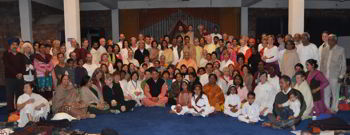 |
||||
| AHYMSIN newsletter, issue - May 2011 | ||||
|
||||
A Successful Yoga Nidra Retreatby Stephen (Stoma) ParkerThe February retreat on yoga-nidra at Swami Rama Sadhaka Grama was two years in the making although many of the details came together in the three months right before the workshop. It was among the most successful programs we have ever hosted at SRSG. There were more than 250 participants, so the ashram was full. This was the first time that we managed to host such a large group without catering the food which was a big step forward for SRSG organizationally. It came about as a response to the fact that programs teaching yoga-nidra are proliferating worldwide using a wide variety of preparatory exercises that are usually mis-characterized as yoga-nidra. These practices often differ from the processes discussed in traditional textual sources and the oral tradition of yoga. Research on yoga-nidra has tended to focus on alpha and theta wave states that, by definition, cannot be yoga-nidra. For this reason, Swami Veda proposed a definition of yoga-nidra which is consistent both with the traditional textual sources and with the parameters indicated in Swami Rama's original demonstrations of yoga-nidra in 1970, the voluntary production of delta waves on an EEG indicating a state of deep, dreamless, non-REM (Rapid Eye Movement) sleep and awareness of one's surroundings.The workshop itself consisted of three parts. The first was a seminar which focused on training participants in the skills that are preparatory to the actual practice of yoga-nidra. Practices were taught by Pierre Lefebvre, Atul Kumar and others on the SRSG staff in addition to our senior faculty. The second part was a research conference that sought to teach about the concept of yoga-nidra both from the perspective of the traditional texts and practices as well as from the perspective of contemporary research in neurophysiology. Swami Veda lectured on the traditional practices associated with yoga-nidra and led sessions in the practice of yoga-nidra. Swami Ritavan spoke on the subtle connections in states of consciousness and also led practice sessions. In addition, various applications of yoga-nidra were examined. Dr. Daniel Jalba spoke about yoga-nidra and self-healing and Swami Nityamuktananda’s topic was creativity and yoga-nidra. Stoma and Chandramani Sharma lectured on yoga-nidra in traditional texts and Dr. Prakash Keshaviah spoke of the profound wisdom found in the Mandukya Upanshad.For the neurophysiological perspective, Shirley Telles Ph.D. of the Patanjali Yogapeetha in Haridvar, the most published scientific investigator of yoga, talked about the neurophysiology of research on yoga and sleep. Dr. Deepak Goel, a neurologist who runs the sleep laboratory at the Himalayan Institute Hospital, described the process of sleep and the nature of disorders of sleep. As a finale to this part of the conference, there was a live experiment where a subject who had been a practitioner of yoga for 40 years was studied intensively in both waking and sleeping examinations on the EEG. The subject was then placed on physiological monitors including an electroencephalogram, a galvanic skin response meter ,and heart rate monitor before a live (and very quiet) audience. The subject then went through a series of subjectively identified states including waking thought, self-hypnosis, mental nadi-shodhana, japa with a mala, silent mantra meditation, and yoga-nidra. During the yoga-nidra phase, when it was clear that the subject was in the state of yoga-nidra, a series of words was read to the subject over speakers in the experimental chamber (the entryway off the Meditation Hall). After the session was over, the subject was asked to repeat the words and repeated the sequence correctly. The readings on the physiological measures were reviewed immediately and it was clear that the subject did produce delta waves on the EEG during the experiment. So the results matched the definition of yoga-nidra proposed by Swami Veda in that delta waves were voluntarily produced and the subject remained aware of their surroundings. Comparison of the delta waves in the experiment to those measured during a sleep study revealed that the yoga-nidra delta waves were slightly faster and of slightly less amplitude than the sleeping delta waves. The subject attributed this to using a brief method of entering yoga-nidra in addition to the fact that this was being done before an audience. There were also small bursts of theta which the subject attributed to reviewing the list of words.In the third part of the workshop, participants continued to refine their practice of the preparatory relaxation exercises and yoga-nidra. The results of the experiment were sufficiently successful that Stoma and Dr. Manuel Fernandez have decided to write the experiment up as a pilot study demonstrating the validity of Swami Veda's proposed definition of levels of yoga-nidra practice. The experiment was a most fitting way to end this ambitious and comprehensive yoga-nidra workshop. |
||||






